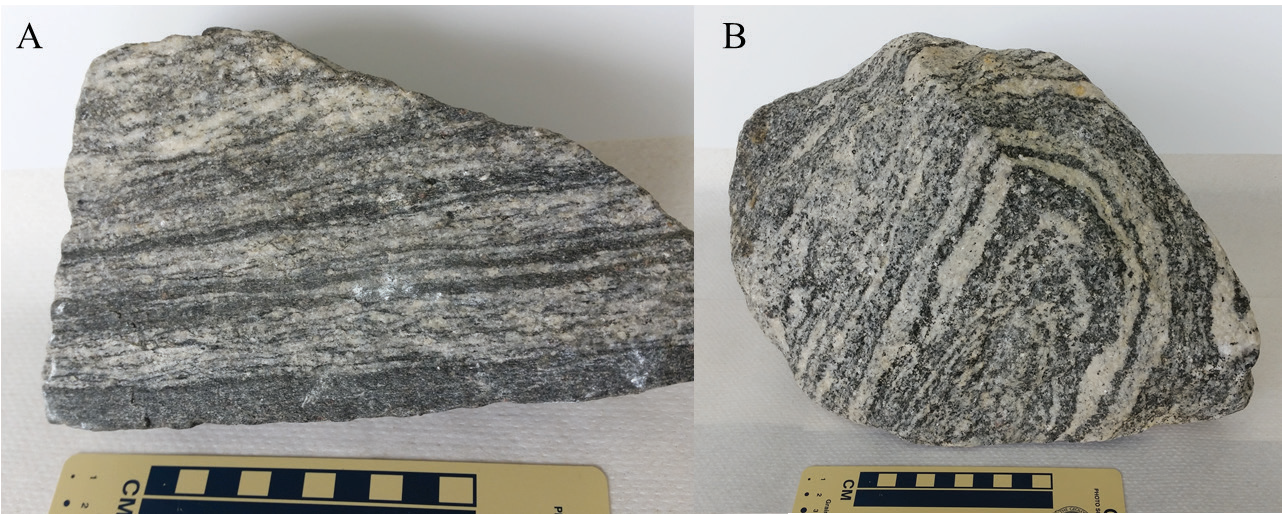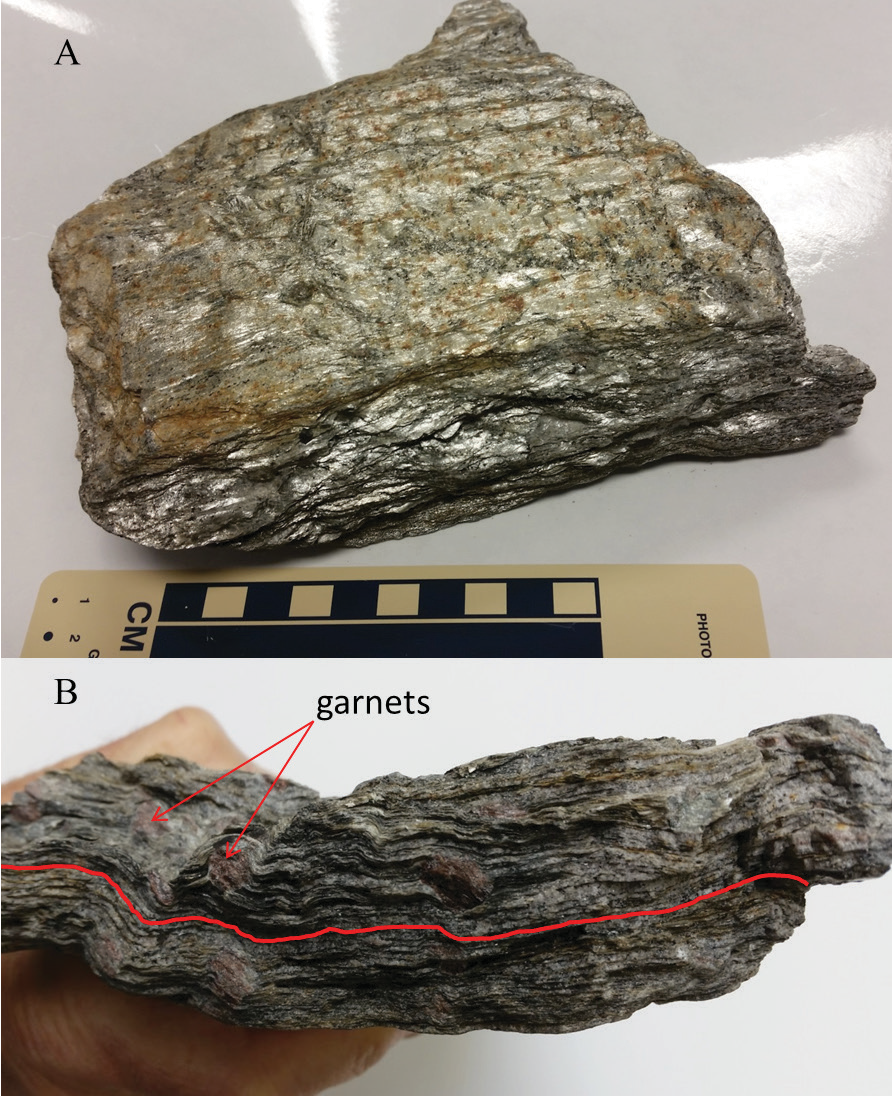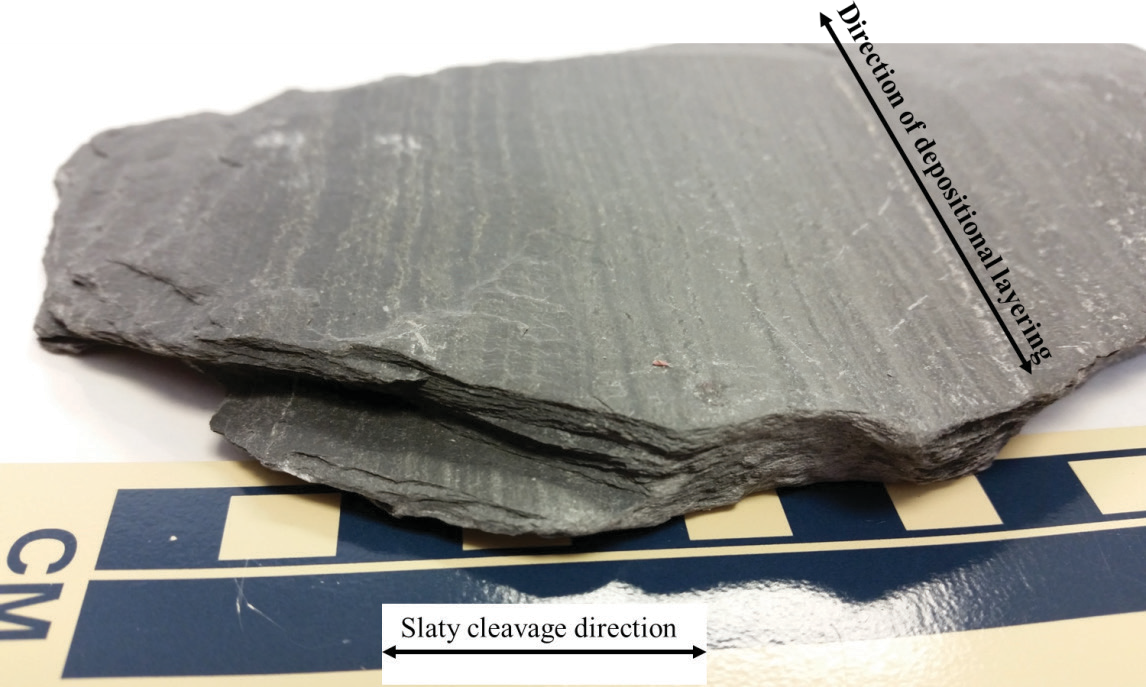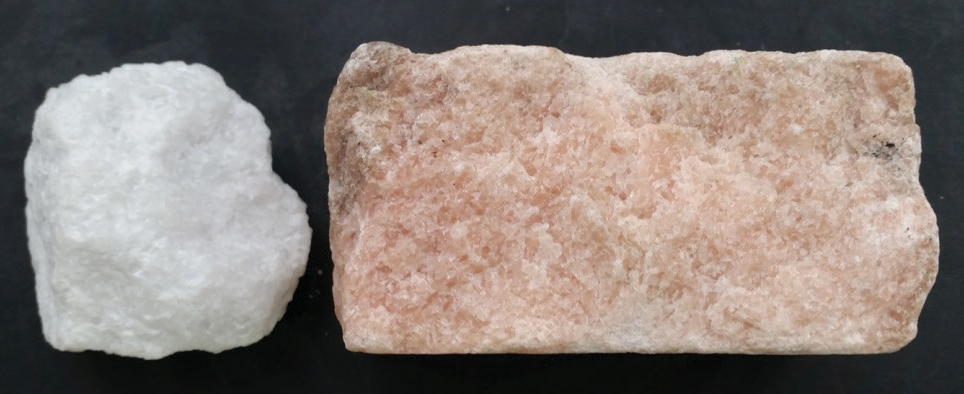1 Exercises on Metamorphic Rocks
Adapted by Lyndsay R. Hauber & Joyce M. McBeth (2018) University of Saskatchewan from Deline B, Harris R & Tefend K. (2015) “Laboratory Manual for Introductory Geology”. First Edition. Chapter 11 “Metamorphic Rocks” by Karen Tefend, CC BY-SA 4.0. View source. Last edited: 8 Jan 2020
Note: much of the overview material for this chapter is replicated in this exercise section for your reference as you complete the lab. You will NOT have access to your lab book or notes for the rock and mineral exam!
Your name: _______________
NSID and student number: ____________
Date and lab section time: _____________
TAs’ names: _______________ __________________
Your TAs will check that you have completed the questions at the end of the lab. Please hold on to your lab notes to help you prepare for the rock and mineral quiz and your lab final exam.
5.3 METAMORPHIC ROCK NAMES
5.3.1 Foliated Metamorphic Rocks
Differential pressures can cause a metamorphic pattern known as foliation to develop in metamorphosed rocks. There are a few types of foliations that are commonly seen in metamorphic rocks, each foliation type is dependent on the minerals that define the foliation. Gneissic banding (e.g. Figure 5.3) is defined as alternating dark and light mineral bands throughout the rock; the metamorphic rock with this type of foliation is called gneiss (pronounced “nice”). The typical minerals seen in the dark coloured bands are biotite and/or amphiboles, whereas the light-coloured bands are typically quartz or light-coloured feldspars. The protoliths for gneiss can be any rock that contains more than one mineral, such as shale with its clay minerals and clay-sized quartz and feldspar, or an igneous rock with both dark-coloured ferromagnesian minerals and light-coloured non-ferromagnesian minerals (see Chapter 3 for review). In order for gneissic foliation to develop, temperatures and pressures need to be quite high; for this reason, gneiss rocks represent a high grade of metamorphism.

Source: Karen Tefend (2015) CC BY-SA 3.0 view source
Another type of foliation is defined by the presence of flat or platy minerals, such as muscovite or biotite micas. Metamorphic rocks with a foliation pattern defined by the layering of platy minerals are called schist; the rock name is commonly modified to indicate what mica is present. For example, Figure 5.4 is a photo of a muscovite schist, with garnet present, so the correct name for this rock is a garnet muscovite schist. By convention, when naming a metamorphic rock the mineral in the lowest quantity is mentioned first. The muscovite micas define a very wavy foliation in the rock; this textural pattern of wavy micas is called a schistose foliation (e.g. Figure 5.4B). Shale is usually the protolith for schist; during metamorphism, the very tiny clay minerals in shale recrystallize into micas that are large enough to see unaided. Temperatures and pressures necessary for schistose foliation are not as high as those for gneiss; therefore, schists represent an intermediate grade of metamorphism.

Source: Karen Tefend (2015) CC BY-SA 3.0 view source
Another metamorphic rock is called phyllite, which is made up of fine crystals that give the rock a shiny appearance. This rock displays phyllitic foliation, which has good, sometimes wrinkled or folded, cleavage. Phyllites are generally formed from a shale protolith, with the clay minerals in the shale aligning and recrystallizing as small mica minerals. This foliation was formed under temperatures and pressures less than those for schist and represents a low to intermediate grade of metamorphism.
The next type of foliation is only seen in the metamorphic rock called slate, which forms by the low temperature and pressure alteration of a shale protolith. The clay sized minerals in the shale recrystallize into very tiny micas, which are larger than the clay minerals, but still too small to be visible. The alignment of these micas control how the slate breaks, and it tends to break parallel to the mica alignment. Since we are unable to see the aligned micas, we can use the alignment of the rock fracture pattern to define the foliation, as the rock is cleaved or split. This is called slaty cleavage, and a rock displaying this foliation type is called a slate. Figure 5.5 is an example of the foliated slate displaying slaty cleavage; notice that this rock has retained its original sedimentary layering, which is quite different from the foliation direction. Slate is an example of a low grade metamorphic rock, as the original sedimentary features and, occasionally, fossils may be preserved due to the low temperatures and pressures barely altering the shale protolith.

Source: Karen Tefend (2015) CC BY-SA 3.0 view source
5.3.1 Non-Foliated Metamorphic Rocks
The other class of metamorphic rocks is non-foliated; the lack of foliation may be due to a lack of differential pressure involved in the metamorphic process, however, this is not necessarily the case for all non-foliated metamorphic rocks. If the protolith rock is only composed of one mineral type, such as limestone or a sandstone with only quartz sands, then a foliation will not develop, even with differential pressure. The calcite mineral in limestone and the quartz sands in sandstone are neither platy minerals, nor are there different coloured minerals in these rocks. The calcite and quartz minerals recrystallize into equigranular, coarse crystals (e.g. Figure 5.2B), and the metamorphic rocks that they make are named by their composition, not by foliation type. For example, Figure 5.6 is quartzite, a metamorphosed quartz-rich sandstone, while Figure 5.7 shows two examples of marble; note that colour can vary for both marble and quartzite. Quartzite and marble may be hard to identify based on appearance, therefore, you must rely on the properties of the minerals that comprise these rocks; you may recall that quartz is harder than glass, while limestone is softer than glass. If you zoom in for a close view of the marble in Figure 5.7, you will see the calcite crystals are fairly large compared to the quartz crystals in the quartzite in Figure 5.6; this can be attributed to the temperature of metamorphism, as higher temperatures result in larger crystals.

Source: Karen Tefend (2015) CC BY-SA 3.0 view source

Source: Karen Tefend (2015) CC BY-SA 3.0 view source
In order to identify and name metamorphic rocks, a logical first step would be to examine the rock for evidence of any pattern or foliation, and if present, identify which minerals are making the foliation pattern. Non-foliated metamorphic rocks can be identified by the properties defined by their mineral composition. Below is a table summarizing the metamorphic rock types, foliation names, and protolith rock types.

Source: Lyndsay Hauber & Joyce M. McBeth (2018) CC BY 4.0 after Karen Tefend (2015) CC BY-SA 3.0 view source
5.4 LAB EXERCISES – METAMORPHIC ROCK IDENTIFICATION
In the sedimentary lab exercise, you had previously obtained the 10 metamorphic rock samples from the drawer provided by your TA; they are numbered 51-60. It is recommended that you have your glass plate, streak plate, and magnifying glass readily available.
Fill in chart 5-E1 as you work through the lab, similar to the charts you completed in the previous labs. You do not have to fill out every column for every rock – just follow along in the lab and determine the properties you are asked about. Work through the following questions, they will help guide you in learning the properties and characteristics of the rocks in this lab.

Source: Lyndsay Hauber (2018) CC BY 4.0
- Sample 51: This rock has which texture?
- slaty cleavage
- schistose foliation
- gneissic banding
- phyllitic foliation
- non-foliated
- Sample 51: What is this rock called?
- marble
- quartzite
- schist
- slate
- gneiss
- phyllite
- Sample 52: This rock has which texture?
- slaty cleavage
- schistose foliation
- gneissic banding
- phyllitic foliation
- non-foliated
- Sample 52: What is this rock called?
- marble
- quartzite
- schist
- slate
- gneiss
- phyllite
- Sample 52: What kind of mineral crystals does this rock mainly contain?
- biotite
- amphibole
- muscovite
- calcite
- quartz
- Sample 52: What is this rock an example of?
- high grade of metamorphism
- intermediate grade of metamorphism
- low grade of metamorphism
- any of the above
- Sample 53: This rock has which texture?
- slaty cleavage
- schistose foliation
- gneissic banding
- phyllitic foliation
- non-foliated
- Sample 53: What is this rock called?
- marble
- quartzite
- schist
- slate
- gneiss
- phyllite
- Sample 53: What is a possible protolith for this rock?
- basalt
- granite
- sandstone
- limestone
- shale
- Sample 54: This rock has which texture?
- slaty cleavage
- schistose foliation
- gneissic banding
- phyllitic foliation
- non-foliated
- Sample 54: What is this rock called?
- marble
- quartzite
- schist
- slate
- gneiss
- phyllite
- Sample 54: What are the dark minerals in this rock?
- flat biotite micas
- tabular amphiboles
- flat muscovite micas
- tabular feldspars
- Sample 54: What is a possible protolith for this rock?
- an ultramafic rock
- basalt
- limestone
- granite
- sandstone
- Sample 55: This rock has which texture?
- slaty cleavage
- schistose foliation
- gneissic banding
- phyllitic foliation
- non-foliated
- Sample 55: What is this rock called?
- marble
- quartzite
- schist
- slate
- gneiss
- phyllite
- Sample 55: What mineral is this rock mainly composed of ?
- biotite
- amphibole
- muscovite
- calcite
- quartz
- Sample 55: What is a possible protolith for this rock?
- basalt
- granite
- sandstone
- limestone
- shale
- Sample 56: This rock has which texture?
- slaty cleavage
- schistose foliation
- gneissic banding
- phyllitic foliation
- non-foliated
- Sample 56: What is this rock called?
- marble
- quartzite
- schist
- slate
- gneiss
- phyllite
- Sample 56: What is a possible protolith for this rock?
- basalt clay
- sandstone
- rhyolite
- shale
- Sample 57: This rock has which texture?
- slaty cleavage
- schistose foliation
- gneissic banding
- phyllitic foliation
- non-foliated
- Sample 57: What is this rock called?
- marble quartzite
- schist
- slate
- gneiss
- phyllite
- Sample 58: This rock has which texture?
- slaty cleavage
- schistose foliation
- gneissic banding
- phyllitic foliation
- non-foliated
- Sample 58: What is this rock called?
- marble
- quartzite
- schist
- slate
- gneiss
- phyllite
- Sample 58: What is this rock an example of?
- high grade of metamorphism
- intermediate grade of metamorphism
- low grade of metamorphism
- any of the above
- Sample 59: This rock has which texture?
- slaty cleavage
- schistose foliation
- gneissic banding
- phyllitic foliation
- non-foliated
- Sample 59: What is this rock called?
- marble
- quartzite
- schist
- slate
- gneiss
- phyllite
- Sample 59: What mineral is this rock mainly composed of?
- biotite
- amphibole
- muscovite
- calcite
- quartz
- Sample 59: What is this rock an example of?
- high grade of metamorphism
- intermediate grade of metamorphism
- low grade of metamorphism
- any of the above
- Sample 60: This rock has which texture?
- slaty cleavage
- schistose foliation
- gneissic banding
- phyllitic foliation
- non-foliated
- Sample 60: What is this rock called:
- marble
- quartzite
- schist
- slate
- gneiss
- phyllite
- Sample 60: What is a possible protolith for this rock?
- basalt
- granite
- sandstone
- limestone
- shale

